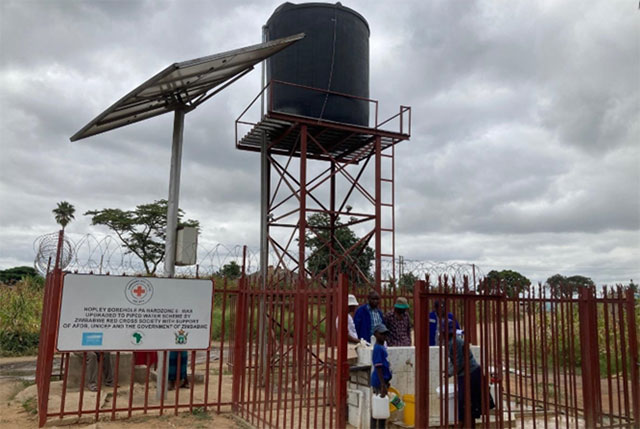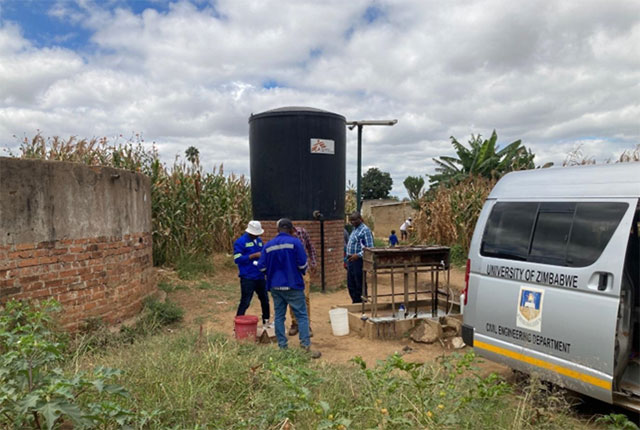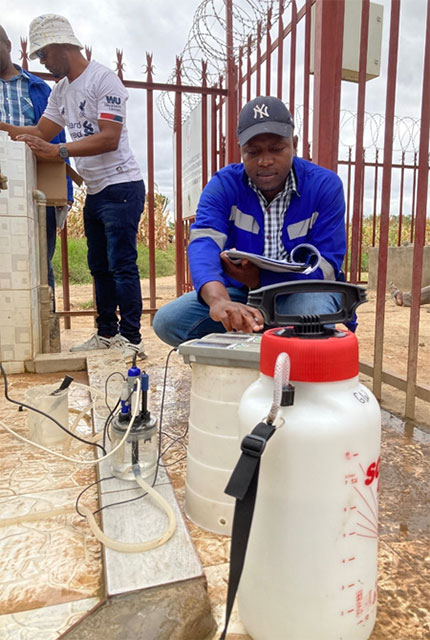Harare’s clean drinking water challenge
Researchers from BGS and partners in Zimbabwe report on the urban water supply challenge in the capital city, Harare.
31/05/2023
BGS is collaborating with the University of Zimbabwe (UZ) in a study to assess access to clean drinking water sources across the city of Harare and the impact of recent donor-led upgrades to groundwater supply systems.

A recently upgraded community groundwater drinking-water point equipped with a solar pump and non-functioning, insitu chlorination system. Dan Lapworth, BGS © UKRI.
A fragile municipal water supply
Harare is Zimbabwe’s capital, with a population of approximately 1.5 million in urban Harare and another 1.1 million living in the satellite towns of Chitungwiza, Norton, Epworth and Ruwa (ZIMSTAT, 2022).
The city’s main drinking water source, Lake Chivero, its tributaries are heavily polluted by industrial waste and raw sewage inflows and the city’s drinking water treatment works are insufficient to supply Harare’s water demand.
Daina Mudimbu, geoscientist at ZIVA Data & Knowledge Management Consultants.
The water system was designed in the 1960s and produces approximately 704 megalitres (ML) of water per day against an estimated demand of between 800 ML to 1300 ML of daily water consumption (ZimFact, 2021).
Frequent outbreaks of waterborne disease
The response of the city water department has been to ration water, leading to an erratic piped water supply to communities that has been associated with a rise in outbreaks of waterborne diseases. In 2008 and 2009, Zimbabwe experienced one of the worst cholera outbreaks, resulting in the many deaths of mostly urban dwellers.
A city dependent on groundwater sources
The aged and inadequate infrastructure for water and waste-water treatment, increased drought and poor revenue collection from water surcharges on households have hampered the municipal water supply system, leading to greater dependence on groundwater.
Recurrent droughts of the 1980s and 1990s ushered in rampant drilling of private boreholes. This has culminated in the drying up of some shallow wells across the city, due to over-pumping.
Moses Souta, technician at the Department of Construction and Civil Engineering, University of Zimbabwe.
The failure of municipal infrastructure to meet the growing potable water demand has given rise to dependence on groundwater, with reports of 80 per cent of Harare’s population relying on groundwater supply (SADC-GMI, 2022).
During a trip to Harare in January 2023, BGS’s Bentje Brauns was able to visit a number of community drinking water sources.
You can see the impact of recent donor programmes to try and improve access to water in high-density settlements through developing groundwater resources. This has included upgrading boreholes and the installation of a large number of solar pumps, water tanks and in situ chlorination systems.
Bentje Brauns, BGS Hydrogeologist.
The challenge of finding drinking water
Though the city’s geology is variable, it is mostly ‘hard rock’ basement geology, therefore groundwater occurrence is controlled by the presence of fractures. As a result, in some suburbs where there are few fractures, drilling may be unsuccessful or boreholes may only work for part of the year because of limited recharge through the fracture network. Poor sanitation and waste management as well as increasing urban pollution have compounded the challenge and have led to groundwater contamination. Some boreholes have been condemned as seasonal cholera and typhoid outbreaks affect communities.
Have recent donor upgrades to community supplies been effective?
A host of donors have worked in recent years to improve and upgrade groundwater drinking sources in high-density settlements across the city in response to this worsening water crisis. Recent communal borehole development projects include the establishment of community water point committees. These committees mobilise local resources, including household monetary contributions, to maintain the water point and continue with chlorination initiated by the donors when the borehole was completed. However, continued chlorination has been reported to be a challenge at many water points because the communities fail to raise the required funding, or the water point committees fail to thrive.
The question remains: have these upgraded sources been effective in providing improved drinking water quality and can they be sustainable, at least in the medium term?
Dan Lapworth, BGS Principal Hydrogeochemist.
We are trying to answer these questions through our collaboration to inform future policy on groundwater development in Harare and elsewhere in this region.
Samson Shumba, engineer and chairman of the Department of Construction and Civil Engineering, University of Zimbabwe.
Assessing groundwater quality in recently improved and historical sources
Monitoring groundwater resources and quality is critical to ensuring the sustainability and safety of water supplies. While big steps have been made recently in implementing monitoring systems, gaps in our understanding certainly remain and opportunities exist for closer monitoring of the water quality and quantity.

University of Zimbabwe team collecting water samples and taking field measurements. Dan Lapworth, BGS © UKRI.
Funding
This work is being undertaken as part of the International Geoscience Research and Development (IGRD) project ‘Geoscience to tackle global environmental challenges’ (NERC reference NE/X006255/1). This is a £12 million project lasting until 2026, looking at challenges facing communities around the globe, including clean water availability, earth hazards and climate change impacts.
About the authors

Dr Bentje Brauns
Hydrogeologist

Dr Daniel Lapworth
Principal hydrogeochemist

Prof Alan MacDonald
Head of BGS Groundwater
Daina Mudimbu, geoscientist at ZIVA Data & Knowledge Management Consultants
Richard Owen, consultant hydrogeologist at the Africa Groundwater Network
Samson Shumba, engineer and chairman of the Department of Construction and Civil Engineering, University of Zimbabwe
Moses Souta, technician at the Department of Construction and Civil Engineering, University of Zimbabwe
Researchers from BGS and partners in Zimbabwe report on the urban water supply challenge in the capital city, Harare.
Broderick, T J. 2012. Notes on the Harare Groundwater Situation. Accessed on 29 August 2022.
Manzungu, E, Mudenda-Damba, M, Madyiwa, S, Dzingirai, V, and Musoni, S. 2016. Bulk water suppliers in the city of Harare – an endogenous form of privatisation of urban domestic water services in Zimbabwe? Water Alternatives, Vol. 9, 56–80.
SADC-GMI. 2022. SADC-GMI Completes Groundwater Monitoring Project in Greater Harare. Accessed on 30 August 2022.



